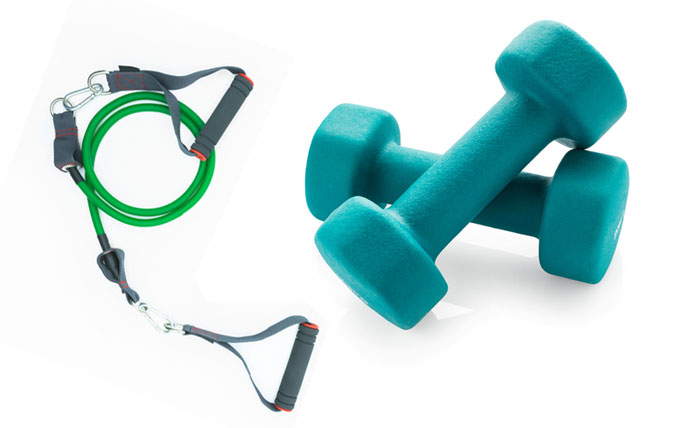
In this post, we are going to explain why you should own a set of resistance bands, the benefits you will gain from incorporating them into your workout routine and give you some tips on purchasing quality bands.
Are resistance bands any good
Some people dismiss resistance bands believing that they are only for true beginners or rehabilitation tools. However, these people are not only mistaken, they are missing out on the benefits that are specific to resistance band workouts. Resistance bands prove that a lot can be done on a relatively light load to train and strengthen the muscles.
What are resistance bands and what are they used for?
Resistance bands are rubber bands that are used for strength training, rehabilitation and balance training, either alone or in combination with other equipment. They come in a range of sizes and thicknesses, all of which change the resistance level of the band.
Resistance bands work by adding resistance to exercises, which fights against the muscle as it tries to move. As we know, muscles need to be sufficiently stressed to cause microtears in the muscle fibres, which strengthen the muscle when healed. A common misconception is that increasing the load on the muscle is the only way to progress in strength training.
This is why free weights are (wrongly) seen as the more ‘serious’ equipment that is suitable for people who are chasing gains.
Do resistance bands help build muscle?
One of the leading benefits of resistance band training is that it can target elements of the muscle that might be otherwise ignored through standard free weight training.
Band training is all about steady reps. By slowing everything down, each part of the targeted muscle must bear the weight, rather than the stronger part of the muscle quickly taking over. This ensures a more evenly trained muscle.
Resistance band workouts are also comparatively safer than free weight workouts because they have a tight range of motion, which supports good form and helps to prevent the overextension of the muscle. The elastic reigns in your movement so the risk of injury is greatly reduced.
Related Guides
- Are Resistance Bands Good For Strength Training?
- Are Dumbbells Safer Than Barbells?
- Should you wear a weightlifting belt?
- How effective are rowing machines at getting in shape?
- Water-Resistance Rowers vs. Air Rowers – Which is Best for you?
Are resistance bands good for strength training?
Which is better for strength training, resistance bands or dumbbells? The answer is both! Resistance bands are great for beginners and for finetuning even advanced bodybuilders’ strength training.
When combined with dumbbells, they improve form and protect against injury. After training, lighter resistance bands are good for stretching out the muscles, reducing achiness and quickening the recovery period.

Beginners – If you are new to strength training then resistance bands provide the perfect first set of fitness equipment. You can perform a full-body workout using only a few bands. Try searching for guided workout videos on YouTube.
Finetuning – If you are an accomplished weightlifter, then you can use resistance bands to target the weaker parts of your muscles that are not trained effectively through standard weightlifting. Doing so should improve your overall muscle condition, prevent stiff and immobile muscles and challenge you in a new way.
Added to dumbbells – Adding a resistance band to your normal dumbbell workout does two things. First, it increases the intensity of the workout, effectively making your weight ‘heavier’ without adding any weight. Second, it improves your form and reduces the risk of overextension.
Cooldown and post-workout – Using a light band to stretch out the muscles after a workout or during the recovery period relieve the pain that can come with a tough session and shorten your recovery.
Should you buy some resistance bands
There are a couple of things you should be aware of when choosing resistance bands. Unlike weights, which are measured by mass, they typically come in ‘resistance levels’, generally something like ‘light’, ‘medium’, ‘hard’, ‘extra hard’ depending on the manufacturer. Because they are not standardised, it can be difficult to compare different brands of bands.
Some tips for buying bands are:
- Looped bands are best for training the lower body.
- Bands with a higher resistance are suitable for strength training to build muscle mass. Bands with a lower resistance level are better for stretching.
- Price is not an indication of quality. A lot of high street fashion stores sell bands. With these, you are often paying for the brand, not the band!
Some downsides and negatives to resistance bands
- They will wear out eventually – Unlike dumbbells or kettlebells, resistance bands don’t last forever and even good quality bands will wear out eventually. The danger of a band snapping misuse is pretty low, but you should still regularly inspect your bands for rips or tears and replace damaged ones. Also, store your bands in a cupboard or some other dark place because sunlight can cause the material to degrade.
- To get the most from them, you’ll need somewhere to anchor them – There are a lot of exercises you can do with bands that don’t require somewhere secure to tie them but some of the best ones (like bench press) need somewhere super-sturdy to wrap them around.
The Verdict: Resistance bands – good or bad?
If you’re still on the fence about resistance bands, here’s a quick summary of why you absolutely need this bit of kit in your home training arsenal:
- They’re incredibly cheap
- Great for strength training
- Come in a range of strengths that will suit anyone
- Safer than free weights like dumbbells
- Extremely good for stretching muscles
- Quick and easy to store






